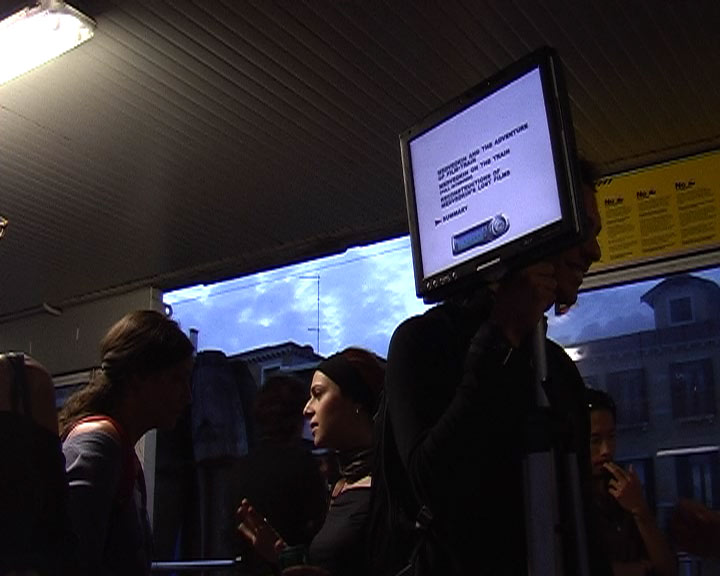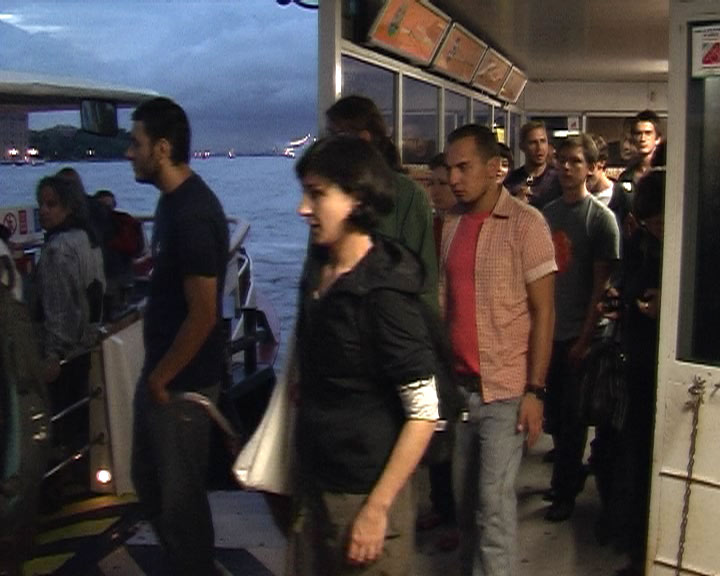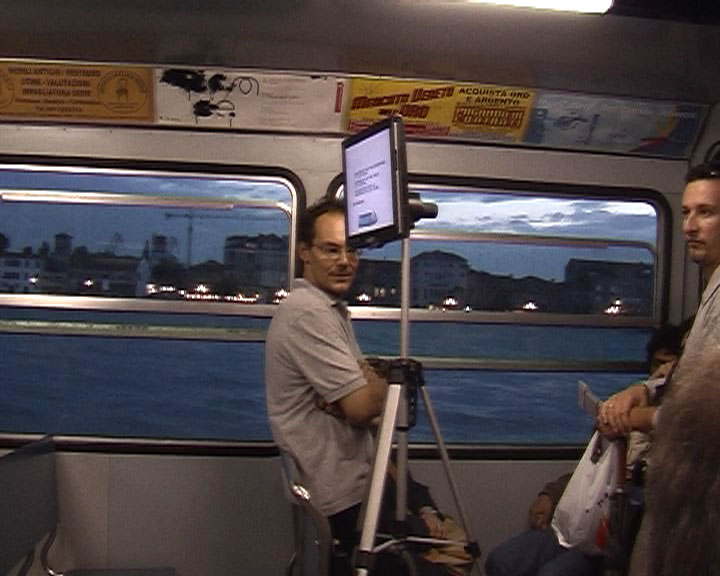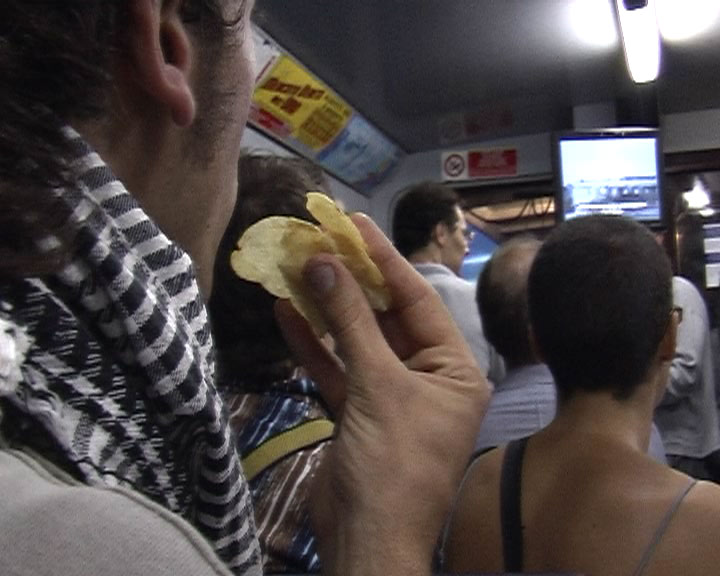

Venerdì - 09.09.05 - Intorno al Cine-Train - Around Cine-Train/Poezd




Tematica:
1. Su questo venerdì
About this Friday
2. Sul Cine-Train
About Cine-Train
3. Su Chris Marker e Alexandre Medvedkine
About Chris Marker e Alexandre Medvedkine
____________________________________________________________________
1. Su questo Venerdì
Cosa: Visione di un film in vaporetto
Quando: 7:00 pm, Venerdì 9 Settembre 2005
Dove: In vaporetto, sulla linea 82, direzione Zattere-Rialto, Venezia
Chi: Tutti sono invitati
Intorno si incontra sulla linea 82 (direzione Zattere`Rialto) per vedere
l'intervista fatta da Chris Marker ad Alexandre Medvedkine sull'esperienza
del Cine-Train; On the train e' un estratto della versione integrale del
film di Marker Le train en marche (1971). Proponiamo la visione di tale
documento in vaporetto da una parte per estendere la possibilita' di
diffusione del film a piu' persone, e, dall'altra per lo spostamento, come
risposta alla mobilita' nei metodi di produzione del cine-train.
____________________________________________________________________
1. About this Friday
What: Discussion
When: 7:00 pm, Friday 9th September 2005
Where: On the boat, line 82, Zattere-Rialto direction, Venice
Who: Everyone is invited
Intorno meets on the boat, line 82 (Zattere~Rialto direction) to watch the
interview made by Chris Marker to Alexandre Medvedkine on the experience
of Cine-train; On the train is a footage of the whole version of the
film by Marker Le train en marche (1971). We propose the screening on
the vaporetto on one hand to extend the possibility of diffusion of the
film to more people and on the other hand for the displacement as a
response to his mobility in the method of production.
____________________________________________________________________
2. Sul Cine-Train
"Subito dopo Ottobre il treno si mette in marcia. Attraverso il treno il
sangue della Rivoluzione circola [...] Agitazione Propaganda Cultura
LITIERATOURA / Letteratura che significa "tutte cose stampate" e di
conseguenza anche il cinema Voitures-cinéma Traîneaux-cinéma Bateaux
d'Agit-Prop portatori di film e qualche volta anche delle telecamere
L'immagine era muta Il suono cieco Il film si costruiva nelle menti"
in Avant-Scène Cinéma, 120 (dicembre 1971), numero speciale : Medvedkine. Le Bonheur (1934), p. 12
Il cine-treno (Kino-Poezd) è stato inventato dal cineasta Alexandre
Medvedkine. La parola d'ordine è " mostrare oggi ciò che non va, mostrarlo
per l'interesse del domani, discuterne abbastanza con gli altri e filmare
nuovamente, una settimana, un mese più tardi, per giudicare i
cambiamenti". Tra il 1932 ed il 1935, una trentina di realizzatori
attraversano l'URSS, facendo cinema collettivo in presa diretta sulla
vita. I documenti filmati andranno spesso perduti. Il cinema degli anni
'30 è proteiforme: strumento di propaganda, esso è anche segnato da una
ricerca e da un arricchimento ereditato dalle innovazioni formali degli
anni '20. A partire dal 1934, la dottrina del realismo socialista impone
una visione eroica e stereotipata della realtà ma il movimento creatore
non viene comunque fermato.
All'inizio degli anni trenta, Alexandre Medvedkine, attraversa l'URSS a
bordo di un cine-treno. Grazie a questa unità di produzione mobile,
durante quasi un anno, realizza insieme a contadini, operai, minatori,
ferrovieri che può mostrare subito dopo. Questi film mostrano i buoni
esiti e gli scacchi di un paese che si credeva allora in costruzione. In
mezzo alle immagini, si inseriscono delle animazioni come commenti:
"compagni questo non può più continuare!", "compagni bisogna che questo
cambi!" Il principio era di "filmare oggi, mostrare domani" e discutere
sulle questioni poste dal popolo a partire da questi film girati sul loro
luogo di lavoro.
Un mezzo-vagone era dedicato al laboratorio, un altro al montaggio ed un
intero vagone come abitazione per i 32 partecipanti. "Eravamo giovani,
romantici ed entusiasti". L'avventura comincia un Ukraina dove i contadini
non sono abituati al sistema dei kolkhozes. I film mettevano a confronto i
buoni ed i cattivi metodi, generando dibattiti nei quali i contadini
discutevano intensamente. I metodi erano quelli della critica diretta ed
una delle armi principali di questi film era il riso. Di questa avventura
non rimane alcun film, solamente alcune fotografie. In Francia nel 1969 un
gruppo di operai riuniti per creare un cinema combattente ha preso il nome
di Medvedkine: "Il più grande errore che si è potuto fare sul tema del
cine-treno, è stato credere che si è fermato".
____________________________________________________________________
2. About Cine-Train
"Immediately after October the train sets its gears. Through the train the
blood of revolution circulates (...) Agitation Propaganda Culture
LITIERATOURA/ Literature which means "all things are printed" and
therefore also cinema Voitures- cinema Traineaux- cinema bateaux d'Agit
Prop bearer of film and also sometimes videocameras the image was mute
the sound blind the film was constructed in the minds."
in Avant-Scène Cinéma, 120 (dicembre 1971), numero speciale : Medvedkine. Le Bonheur (1934), p. 12
The cine train was invented by the director Alxandre Mavedkine. The word
of order was to "show today what is wrong, show it for the interest of
tomorrow, discuss a lot with others and film again, a week, a month
later, to judge the changes." Between 1932 and 1935, about thirty
directors ride through the URSS, making collective cinema taken directly
from life. The documents filmed will be lost in time. The cinema from the
1930's is proteiform: as instrument of propaganda, this is also marked by
a research and enrichment inherited from the formal innovations of the
20's. From 1934, the doctrine of the social realism imposes a heroic and
stereotyped vision of reality but the creative movement does not put a
stop to its possibilities.
At the beginning of the thirties, Alexandre Medvedkine, crosses the URSS
on board of a cine train. Thanks to this mobile unit of production, for a
year, produces together to peasants, workers, miners, and railway workers
that which could be shown afterwards. These films show the results and the
step forward of a country which thought itself still in construction.
Between the images, we find animations wth comments like " comrades, this
cannot go on", " comrades we need to stop it".
The principle was to film today, to show tomorrow" and discuss themes
posed to the people from the films shot in their places of work.
Half a wagon was dedicated to a laboratory; another one to editing and
there was a whole wagon for the residence of the 32 participants. "We were
young, romantic and enthusiasts." The adventure starts in Ukraine where
the farmer are not used to the system of the kolkhozes. The films
confront the good and the bad methods, generating debates in which the
farmers discussed intensely. The methods were those of the direct critic
and one of the principle arms of these films was the laughter. No film
remains from these adventures, just some photographs. In France in 1969, a
group of workers united to create a fighting cinema has taken the name of
Medvedkine: "The biggest mistake of the cine-train is to believe that it
has stopped".
____________________________________________________________________
3. Su Chris Marker e Alexandre Medvedkine
Chris Marker ha realizzato due film su Medvedkine: Le Tombeau
d'Alexandre/The last Bolshevicknel 1998 e Le Train en marche nel 1971.
Il cineasta russo, Alexandre Medvedkine, nasce l'otto marzo 1900,
combattente nella prima armata della cavalleria Rossa durante la guerra
civile che seguì la Rivoluzione del 1917. Fra due operazioni contro i
Bianchi, egli realizza delle operette satiriche per sostenere il morale
dell'armata. A ventisette anni, abbandona il suo cavallo per un treno, il
teatro per il cinema, e prende la direzione del "cine-treno", che solcherà
l'Unione Sovietica non per portare la buona parola ma la buona immagine
nelle contrade più arretrate dove non si sapeva cosa fosse un cinema.
" Per Medvedkine -si dice in un breve testo anonimo che lo presentava nel
1971 al pubblico francese, che non ne aveva mai sentito parlare- si tratta
di brandire il cinema contro il nemico: retroguardia delle armate bianche,
koulaks, burocrate, imbecilli. Armate gli schermi sovietici di un pensiero
politico. Create una unità di produzione mobile: un treno. In programma:
filmare oggi il popolo. Proiettare domani davanti al popolo. Treno di
combattimento, treno di vita. Treno di sogni in un paese senza treni. Tre
vagoni, due per un laboratorio, sei tavoli di montaggio, una camionetta,
delle telecamere. Il terzo per i 32 membri dell'equipe che girano fino nei
cantieri, delineano le difficoltà della produzione, filmano, unendo
un'acuta critica a degli esempi chiari e positivi, narrando come la gente
possa essa stessa mettere dell'ordine presso di sé."
Gli operai del Doubs vi si riconobbero facilmente. Tutto era cominciato da
loro nel marzo del 1967, due anni prima che fosse stato evocato, per la
prima volta in Francia senza dubbio, il nome di Medvedkine e l'esperienza
del "Cine-treno". In questo mese di marzo, dunque, gli operai della
fabbrica di tessuti sintetici Rhodiacéta a Besançon si erano messi in
sciopero. Sciopero che stava durando da settimane. Pol Cèbe, militante
della CGT, responsabile del centro culturale popolare di
Palente-les-Orchamps (CCPPO) a Besançon, bibliotecario del comitato di
impresa della Rhodiacèta, pazzo per le immagini, la letteratura e la
rivoluzione, pensò che questa lotta dovesse avere una risonanza in
Francia. Egli fece appello a Chris Marker, che provvedeva al coordinamento
del film "Lontano dal Vietnam" (1967), al quale partecipavano Alain
Resnais, William Klein, Joris Ivens, Claude Lelouch, Agnès Varda et
Jean-Luc Godard. Marker arriva a Besançon con Mario Marret, e si mette al
lavoro con Bruno Muel, altro cineasta militante.
Esso passò per la prima volta alla televisione, nel programma Caméra 3, il
5 marzo 1968, e la prima proiezione pubblica ebbe luogo a Besançon il 27
marzo seguente.
Alle critiche provenienti dagli operai di fronte alle immagini
propostegli, Chris Marker rispondeva; "Si sarà sempre in mezzo agli
esploratori ben intenzionati, più o meno simpatici, ma dall'esterno e,
allo stesso modo per la sua liberazione, la rappresentazione e
l'espressione verso il cinema della classe operaia sarà la sua stessa
opera. E quando gli operai avranno fra le mani gli apparecchi audiovisivi,
essi ci mostreranno i film sulla classe operaia, e su ciò che è uno
sciopero, e l'interno di una fabbrica."
____________________________________________________________________
3. About Chris Marker e Alexandre Medvedkine
Chris Marker has made two films about Medvedkine: Le Tombeau
d'Alexandre/The last Bolshevicknel 1998 and Le Train en marche nel 1971.
The Russian filmmaker Alexandre Medvedkine, was born the 8th of March
1900, soldier in the first army of the Red cavalry during the civil war
that followed the 1917 Revolution. Between two operations against the
Whites, he makes two satirical works to sustain the moral of the his
comrades. At twenty-seven, Medvedkine abandons his horse for a train,
theatre for cinema, and takes over the direction of cine train, which will
cross the Soviet Union.
For Medvedkine its all about waving cinema against the enemy: rearguard of
the white army, koulaks, bureaucrats, imbeciles. Arm the soviet screens
with a political thought. Create a unit of mobile production: a train. The
program: filming the people. Screen tomorrow in front of the people. Train
of struggle train of life. Train of dreams in a country without trains.
Three wagons, two for a laboratory, six table for editing, one van and
videocameras. The third wagon was for the 32 members of the team that shot
even in construction sites.
The workers of Doubs recognized themselves easily. Everything began in
March 1967, two years before the name of Medvedkine and the experience of
the cine-train was to be evoked. In this month the workers of the
synthetic textile fabric Rhodiaceta in Besancon got on strike for many
weeks. Pol Cebe, militant of the CGT, responsible for the popular cultural
centre of Palente- les-Orchamps (CCPPO) a Besancon, librarian of the
committee of the Rhodiaceta fabric, crazy for images, literature and
revolution, thought this struggle should have a resonance in France. They
made appeal to Chris Marker, that was filming the film "Away form
Vietnam" (1967) with the participation of Alain Resnais, William Klein,
Joris Ivens, Claude Lelouch, Agnes Varda and Jean Luc Godard. Marker
arrives to Besancon with Mario Marret and start working with Bruno Muel.
The film was broadcasted for the first time in television on March 5th
1968 and the first public screening took place next 27th of March in
Besancon.
In response to the critics made by the workers to Chris Marker, he said:
"We will always be in between well intentioned explorers, more or less
sympathetic but always from the outside. For their freedom, representation
and expression of the cinema of the working class will be the shooting of
their own work. So when the workers will have audiovisual means, they will
show us the films of the working class, that which is a strike and the
inside of a fabric."